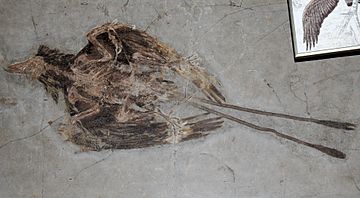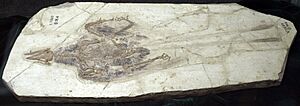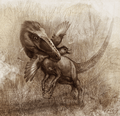Confuciusornis facts for kids
Quick facts for kids Confuciusornis |
|
|---|---|
 |
|
| C. sanctus fossil preserving long wing and tail feathers. | |
| Scientific classification |
|
| Kingdom: | Animalia |
| Phylum: | Chordata |
| Family: | †Confuciusornithidae |
| Genus: | †Confuciusornis Hou et al., 1995 |
| Type species | |
| †Confuciusornis sanctus Hou et al., 1995
|
|
| Species | |
|
|
| Synonyms | |
|
C. sanctus
|
|
Confuciusornis is a type of ancient bird that lived a very long time ago. It was about the size of a crow. These birds lived during the Early Cretaceous period, which was about 125 to 120 million years ago.
Their fossils were found in China, in places called the Yixian and Jiufotang Formations. The bird was named after a famous Chinese thinker, Confucius. He lived a long time before the bird was discovered.
Unlike some other ancient birds, Confuciusornis had a beak without teeth. Modern birds also have beaks without teeth. This shows that losing teeth happened more than once in bird history. This is called convergent evolution.
Confuciusornis is the oldest known bird to have a beak. It was also the first known bird to lose the long tail that Archaeopteryx had. Instead, it had a short tail with fused bones, called a pygostyle.
Many Confuciusornis fossils have been found. Hundreds of complete skeletons have been discovered in the Yixian Formation. This makes it one of the most common ancient animals found there.
Scientists think its toes helped it both walk and perch on branches. Its large claws on its thumb and third finger were probably used for climbing. It might have had a small feathery crest on its head.
How Did Confuciusornis Fly?
Scientists have different ideas about how Confuciusornis flew. Its shoulder joint was set sideways, not angled upward like in modern birds. This might mean it couldn't lift its wings high above its back. If so, it might not have been able to flap its wings strongly like birds today.
Some scientists think it could flap its wings but was especially good at soaring, which means gliding through the air. Other scientists believe it was fully capable of flapping flight.
Many Confuciusornis fossils are found in large groups at the bottom of ancient lakes. This suggests they traveled in big flocks over the water. This kind of behavior fits well with an animal that could fly.
What Color Was Confuciusornis?
In 2010, scientists studied Confuciusornis fossils very closely. They looked for tiny parts called melanosomes. These are like tiny packages inside cells that hold color pigments.
Using a special electron microscope, they found melanosomes in a Confuciusornis fossil. They found two types of melanosomes. This tells us that Confuciusornis probably had colors like grey, red/brown, and black. It might have looked a bit like a modern zebra finch.
Images for kids
-
Birds like the tawny frogmouth might be similar to Confuciusornis in some ways.
See also
 In Spanish: Confuciusornis para niños
In Spanish: Confuciusornis para niños















